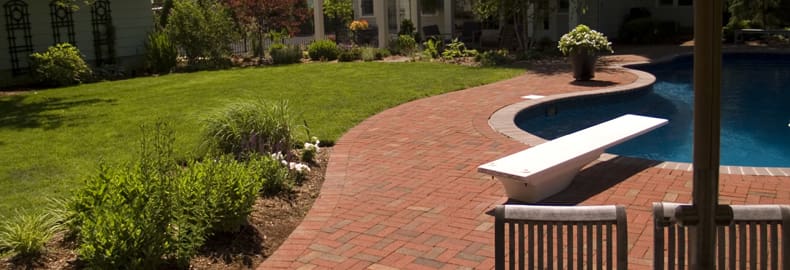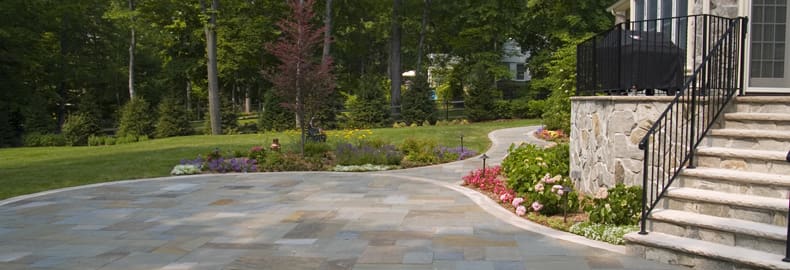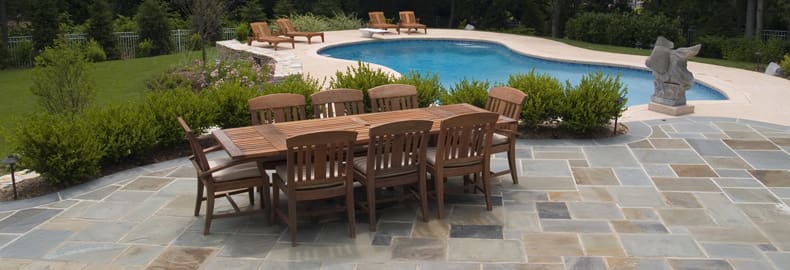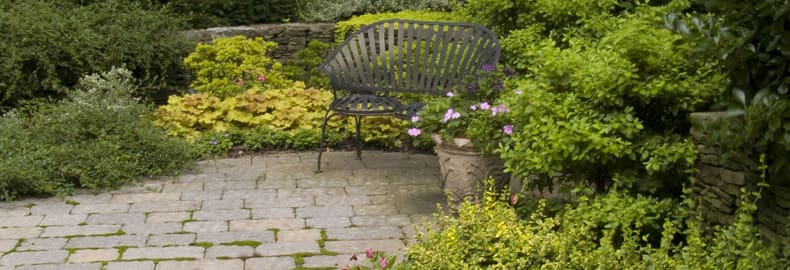An outdoor patio can add years of enjoyment to your home. It’s a great way to expand your indoor living space for entertaining and get outside more with family and friends. An outdoor patio is an asset for any northern NJ home, but what about outdoor patio installation? Is it a DIY project or should you hire a professional contractor?
One of the main considerations of building an outdoor patio is the type of material you plan to use. The material you choose plays a big part in the overall look of your patio, construction costs and whether it should be a DIY or professional project. It also determines the necessary maintenance and care of your Bergen County patio through the years.
Concrete Outdoor Patios
A concrete patio can be poured, built with concrete pavers or built from a precast modular slab. Textures and finishes vary from plain to scored to intricately embossed patterns. Some concrete patterns resemble other materials like slate and quarry stone. Concrete is extremely strong and durable for outdoor patios, but outdoor patio installation procedures vary depending on your selection.
Outdoor concrete pavers are easy to work with and modular shapes create easy installation. Some concrete pavers have interlocking edges that require no grout. Edge spacers provide a uniform installation where pavers simply fit together like puzzle pieces. Concrete pavers are fairly easy for DIY patio installation.
Precast modular slabs are also DIY friendly. Techniques are slightly different than pavers, but installation is not that difficult if you’re willing to exert the needed labor and time required.
Pouring a concrete pad is a very different story that requires a professional. Concrete is made from a mixture of cement, water, sand and gravel. It starts to harden as soon as the water is added to the mixture, so there is absolutely no room for error. If you’re pouring a new concrete slab, hire a professional.
If you have an existing concrete pad that needs a facelift, consider a thin concrete overlay. Overlays can be tinted, stamped, etched and embossed to resemble other materials. Overlays for outdoor patio installation are typically 1/4” thick with no mortar or grout. They provide a clean, durable surface that will last for years and the cost is much less than a new patio.
DIY Information:
Concrete interlocking pavers should be installed on a base of permeable crushed stone and sand. Sand should be used between the paver joints. The joints should be tight enough to prevent things from falling into them, or patio furniture legs getting stuck. Built-in edge spacers make installation easier, but outdoor patio installation does require the use of a vibrating plate compactor. It’s a large machine that can be rented from most home improvement centers.

Brick Outdoor Patios
Brick pavers are great for outdoor patio installation. They are thinner than regular bricks and some have edge spaces to create uniform joints. They are lightweight, easy to handle and simple to install for most DIYers. It’s fairly easy to get a smooth surface by lining up the joints. Brick pavers are fired-clay products that come in muted shades of red, yellow, green, brown, gray and black. They offer a timeless classic appearance for any patio.
Brick pavers can be laid straight, angled or in a herringbone pattern that helps to lock bricks in place. The herringbone design is a popular choice for traditional homes and more formal landscapes in Bergen County, NJ. You can create this pattern with any rectangular brick or paver.
DIY Information:
The trick to successful outdoor patio installation with brick pavers is what happens underneath the patio. First, there must be a strong base made of crushed stone and stone dust on top of the soil. Second, a one-inch thick layer of stone dust on top of the base. Steel edging is required around the second level. When you have a completely level surface, you can begin laying the brick pavers in the design you prefer. Polymeric sand should be used to fill the joints between brick pavers. No grout is needed.

Stone Outdoor Patios
Natural stone pavers can be cut from any type of stone, but the most popular pavers on the market are granite, marble, limestone, travertine and slate. These natural stones are very strong and offer long-term durability for outdoor patio installation.
Stone pavers are available in many different sizes, shapes, textures and colors. Most stone pavers come in tumbled and polished finishes. Tumbled or honed stones have a rough texture that looks very natural and casual. Polished stones have a sheen that provides a more sophisticated, elegant appearance. All natural stones are porous and should be sealed once or twice a year for protection from spills, stains and outdoor weather conditions.
DIY Information:
Setting stone is similar to laying ceramic tile. You need to prepare a base, level each paver and fill in the joints with sand. Interlocking stone pavers have edge spacers that allow you to fit pavers together like puzzle pieces without using grout or mortar. Outdoor patio installation is fairly simple, but it does require an absolutely level surface underneath.

Flagstone Outdoor Patios
Flagstone is typically sold in irregular sizes and shapes. Nothing is in a uniform pattern. Flagstone, with its irregular edges, gives the appearance of natural rock that was found somewhere in the forest. It creates a rustic, casual outdoor patio installation. The colors of flagstone are mostly beige and brown, reminiscent of very earth materials that often look old or recycled.
Flagstone is rather difficult to install and best left to professional installation. It takes skill and time to create a flagstone patio that even and well-proportioned. Each piece of flagstone must be leveled individually. You can’t just spread a layer of bedding sand over the crushed gravel base, then set the flagstone pavers on top. Outdoor patio installation for flagstone patios is more difficult and require more skill than other types of pavers with a uniform thickness.
DIY Information:
A sand layer must be used beneath the irregular flagstone pieces. This allows you to level each paver individually. You have to lift each stone as needed with a pry bar and add or remove sand until each stone is flush with the adjoining ones. If you’re using free-form flagstone, you can plant low ground cover or grass between each flagstone piece for a beautiful, classic natural landscape look.
Outdoor patio installation takes skill, proper tools and equipment and time to do a good job. For best results, hiring a professional landscape contractor in northern NJ is always recommended.

